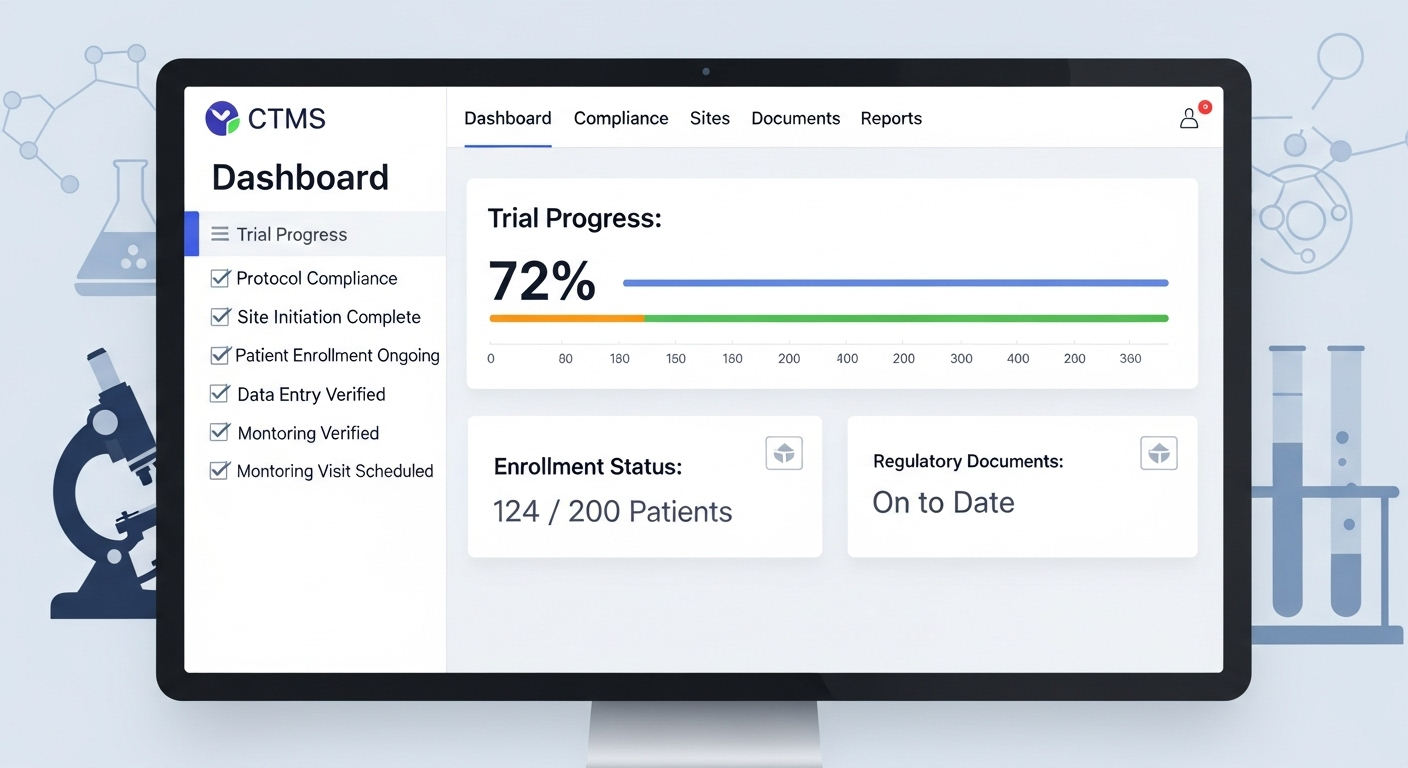What Is a CTMS?
Running a clinical trial is like running a small city: there are countless moving parts, different players with their own responsibilities, and strict rules that keep everything in line. For sponsors, keeping track of it all can quickly become overwhelming. That is where a Clinical Trial Management System (CTMS) comes in.
A CTMS is software built to plan, manage, and monitor clinical trials across their entire lifecycle. Instead of scattered spreadsheets, email chains, and delayed site updates, sponsors can see trial activity in one place, in real time.
At its core, a CTMS gives sponsors:
- Real-time trial data to support better decisions.
- Portfolio-wide oversight across multiple studies.
- Compliance features that keep trials inspection-ready.
- Collaboration tools that help sponsors, CROs, and sites work as a team.
Think of it as the trial’s control tower: watching, tracking, and guiding all the activity that keeps research on course.
Why Sponsors Need CTMS Today
Sponsors face growing challenges. Recruitment targets are harder to hit, regulators expect broader participant diversity, and oversight requirements are stricter than ever. At the same time, sponsors often run multiple studies at once, sometimes across continents. Without centralized visibility, it is easy for things to slip through the cracks.
CTMS addresses these pain points by pulling all the threads together. It does not remove the complexity of clinical research, but it gives sponsors the visibility and tools to manage it more effectively.
The Essentials Every Sponsor Should Expect From CTMS
1. Real-Time Data for Smarter Decisions
In traditional trial management, sponsors often rely on periodic reports from sites or CROs. By the time those reports arrive, weeks may have passed. If enrollment is lagging or a site is struggling, valuable time is already lost.
A CTMS changes that. Sponsors can see live recruitment numbers, site performance metrics, and protocol adherence across all active studies. This real-time visibility means issues are spotted early and can be addressed before they derail timelines. For example, if enrollment is slow at one site, resources can be shifted to another without waiting for the next formal update.
2. Proactive Risk Management and Compliance
Every sponsor knows how much is at stake when compliance falters. A missed deadline, a protocol deviation, or incomplete documentation can delay approvals and raise regulatory concerns.
CTMS platforms reduce this risk by creating digital audit trails that capture every change, every update, and every communication. Sponsors can demonstrate compliance with ICH-GCP standards and FDA regulations without scrambling at the last minute.
More importantly, CTMS helps identify risks before they turn into findings. Automated alerts can flag missing documents, delayed submissions, or unusual site activity so sponsors can act quickly. This proactive approach makes compliance less about firefighting and more about prevention.
3. Improved Sponsor – Site Collaboration
Collaboration between sponsors and sites has always been challenging. Sites often feel burdened by constant reporting demands, while sponsors feel left in the dark when updates are slow. Misalignment here is one of the leading causes of trial delays.
CTMS creates a shared workspace. Secure messaging, centralized task assignments, and dashboards mean everyone sees the same information. Sites know what is expected of them, and sponsors know where things stand without relying on endless email threads.
The result? Fewer misunderstandings, faster issue resolution, and a stronger partnership between sponsors and sites.
4. Portfolio – Wide Oversight
Many sponsors manage more than one trial at a time, often in different phases and therapeutic areas. Without a CTMS, each study is its own silo, and executives have no clear way to view performance across the portfolio.
CTMS provides a single source of truth. Sponsors can compare performance across studies, track overall enrollment progress, and see where bottlenecks are emerging. This portfolio-wide view supports better resource allocation and strategic planning, as highlighted in NIH clinical trial operations resources.
For example, if multiple Phase II trials are competing for similar participants, CTMS data can help sponsors stagger timelines or adjust recruitment strategies to avoid conflicts.
Why Sponsors Should Care Now
The demands on sponsors are only increasing:
- Regulators want more transparency and broader representation in trial populations.
- Sites want easier ways to communicate and fewer administrative burdens.
- Patients want trials to be more accessible and less disruptive to their daily lives.
Sponsors who rely on outdated methods of oversight risk falling behind. Those who embrace CTMS gain:
- Faster, data-driven decision-making.
- Stronger compliance with global regulations.
- Greater visibility across every trial and site.
- More effective collaboration with sites and CRO partners.
- The ability to scale operations without losing control.
CTMS is not just another piece of software. It is the framework that allows sponsors to manage complexity with confidence. By giving sponsors the tools to oversee trials in real time, stay compliant, and strengthen collaboration, DecenTrialz for Sponsors ensures that progress in clinical research does not slow under the weight of operational challenges.

Leave a Reply